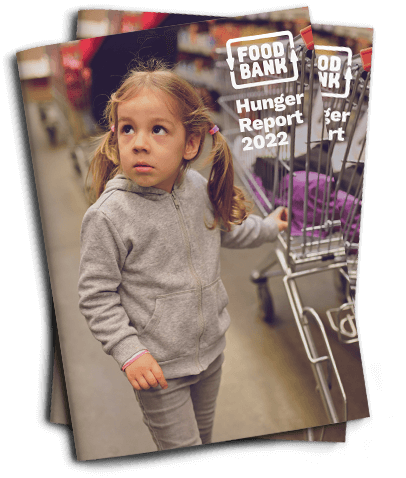“
Same amount of income (husband works) and I am a mum on carers payment for a special needs child. Same bills, same groceries, same amount of clothing/shoes, same amount of fuel for the vehicle etc – the only thing that has changed is that the prices of all the normal things have gone up but income/payments remain the same. So that means now we have to cut down on groceries. Adults go without meals so the kids can eat. So, cutting down on groceries is our only option.
We don’t do anything. We don’t go out for restaurant meals or takeaway, no holidays, don’t buy coffees from cafes. We go out the house for work, grocery shopping, taking kids to school and picking them up, driving to medical appointments and to the local park so our kids can do something over the weekend that is free and close to home. It’s really sad that it’s come to this.
”
A mum in country Queensland
Close panel

“I have witnessed firsthand the rise in demand for food relief services over the past year as the country has been ‘recovering’ from Covid-19, but even I’m shocked by the picture that is exposed in this report.”
A message from Brianna Casey, Foodbank Australia CEOWe know how important it is for people to have access to nutritious food, yet the rising costs of energy, fuel, groceries, rent and mortgages have put this fundamental need beyond the reach of more and more people with no respite in sight. Heart-wrenchingly, families with children are being hardest hit.
The results of this year’s Foodbank Hunger Report should make everyone stop in their tracks. The numbers being reported are massive and hard to process, but behind every one of these numbers is a human face, a real story and in all likelihood, someone you know. They represent the harsh reality of living week to week when the cost of living crisis collides with an income crisis and the household budget now lists food as a discretionary spend.
The report signals that the problem is only set to get worse with half of all food insecure households saying that being unable to afford food is happening more often than last year. Again, those with dependent children are more likely to have felt the rising pressure than those without.
Unfortunately, shame, embarrassment and stigma remain a barrier to people needing food relief actually reaching out for assistance. We are redoubling our efforts to ensure that every person in Australia who needs food relief has access to it for as long as they need it.
Brianna Casey
Foodbank Australia CEO
Close panel
Over 2 million households in Australia (21%) have experienced severe food insecurity in the last 12 months
To show you how many households have suffered from food insecurity in the last year, and how deeply they’ve been impacted, we’ve imagined an average Australian street. Hover on the buttons to find out more.
In the past 12 months, over 2 million Australian households (21%) experienced severe food insecurity, which means they ran out of food because of financial limitations and at worst went entire days without eating.
If this is expanded to also include households experiencing moderate symptoms of food insecurity this increases to a third of surveyed households in Australia (33%), or 3.3 million households, experiencing food insecurity at some point in the last 12 months.
On any given day, over half a million households in Australia are struggling to meet their food needs. For these 520,000 households this means, for example, they and/or their children are having to skip meals, go hungry and/or reduce the size of meals because they couldn’t afford to buy more.
Level of household (HH) food insecurity by demographics

What does being severely food insecure mean in 2022?
Households that have experienced severe food insecurity (or ‘very low food security’ as defined in the HFSSM) have suffered reduced or compromised quality, quantity and adequacy of food they have access to due to financial constraints and have experienced mental stress associated with such situations. Reduced food intake, as well as disruption to normal eating patterns due to the lack of money and other resources for food in the household, is a defining characteristic (e.g. cutting the size of meals or skipping meals, eating less than one feels they should, or going hungry without eating because there wasn’t enough money for food).
Households without children categorised as experiencing severe food insecurity were those that had met six or more such indicators for any (at least one) adult member of the household, whereas households with children classified as experiencing severe food insecurity were those that had met eight or more household or child-specific food insecurity indicators across both adult and child-members of the household over the last 12 months.
Of the respondents in households suffering severe food insecurity:
- 94% “worried whether food would run out before I/we got money to buy more”
- 90% agreed that “the food that I/we bought just didn’t last, and I/we didn’t have money to get more”
- 84% “couldn’t afford to eat balanced meals”
- 97% had cut the size of meals/skipped meals, and 60% hadn’t eaten for a whole day, because there wasn’t enough money for food, for themselves or any other adults in their household. Of those who did experience reduced meal size/meal skipping, 88% had done so for 3 months or longer over the last 12 months.
Of individuals in households experiencing severe food insecurity:
- 96% had eaten less than they felt they should because there wasn’t enough money for food
- 88% reported having gone hungry without eating
- 74% had lost weight because there wasn’t enough money for food.
Among households with children experiencing severe food insecurity:
- 93% stated they “relied on only a few kinds of low-cost food to feed their child/ren because they ran out of money to buy food”
- 79% said they “couldn’t feed their child/ren a balanced meal because they couldn’t afford that”
- 60% said “their child/ren was/were not eating enough because they just couldn’t afford enough food”.
Close panel

“There have been many occasions where the food we’ve purchased for the week has just not stretched far enough as the children are getting bigger and their appetites have increased.”
Read more“
My children are quite big eaters and we try not to eat a lot of pre-packaged snack items, preferring to make things from scratch. The cost of fresh foods and meats has skyrocketed in the past 12 months and there have been many occasions where the food we’ve purchased for the week has just not stretched far enough as the children are getting bigger and their appetites have increased.
I always buy what I think we will need for the week but often find 2-3 days before the next shopping trip we need to do a ‘top-up’ shop for additional items, which is not always possible if we’re between pays. So we’ve had to make things stretch but sometimes it’s just not manageable.
”
Mum in suburban South Australia
Close panel
Households with children are being harder hit
While a broad range of households are struggling, it is those with children which have been hit harder than others in the past year. Single parent households are the worst of all. Hover over the buttons to find out more.
Households with dependent children are particularly vulnerable to food insecurity. More than half (52%) were either moderately or severely food insecure in 2022, 1.6 times higher than the national average of household food insecurity at 33%.
1.3 million children in Australia lived in severely food insecure households in the past 12 months.
Levels of food insecurity in households with children
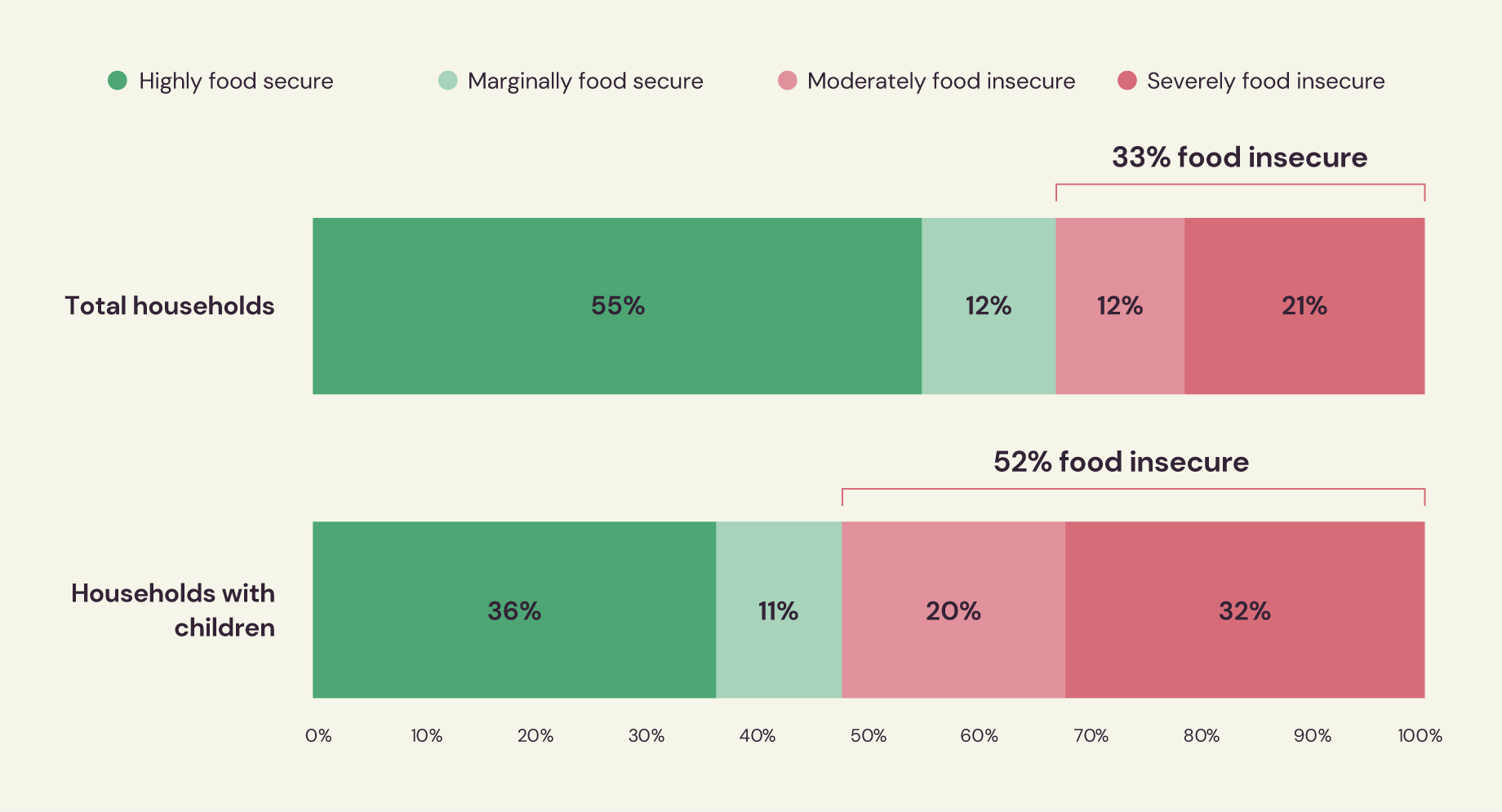
For food insecure households with children, the majority haven’t been able to afford the quantity of food they need for the household.
While half (47%) of families experiencing food insecurity said their children were not eating enough, the more common issue for the children was one of food quality and nutrition.
Key food insecurity indicators: household and child-specific experience
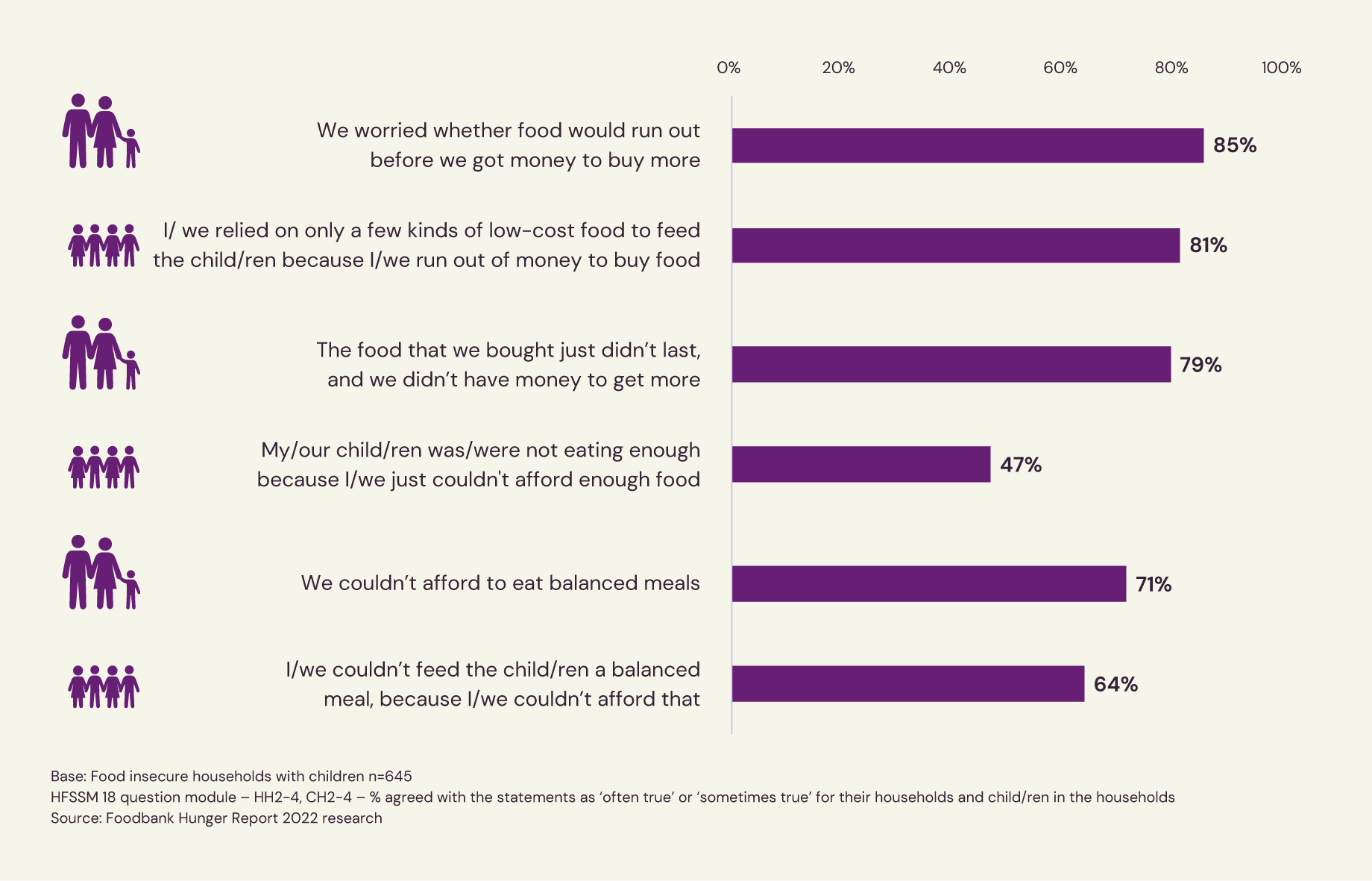
Similar to total food insecure households in Australia, the majority of households with dependent children also report reduced food intake. This is despite the adults’ efforts to protect their children, as indicated in their higher susceptibility to hunger (65%) than the children (45%) when food insecurity strikes. Furthermore, while 50% of adults report not eating for a whole day because there wasn’t enough food, 37% of their children had also gone without eating for a whole day.
Detailed food insecurity indicators for adult- and child-specific experiences

Food insecurity is more frequent and long-lasting for households with children
For food insecure households with dependent children, food insecurity is more frequent (at least several times a week for 28% of households) than for the average food insecure household (23%). It was also likely for the households with children to take a longer time than average to recover, with a third (32%) not being able to afford food for longer than a month vs 28% for the average food insecure household.
Characteristics of food insecurity in affected households with children
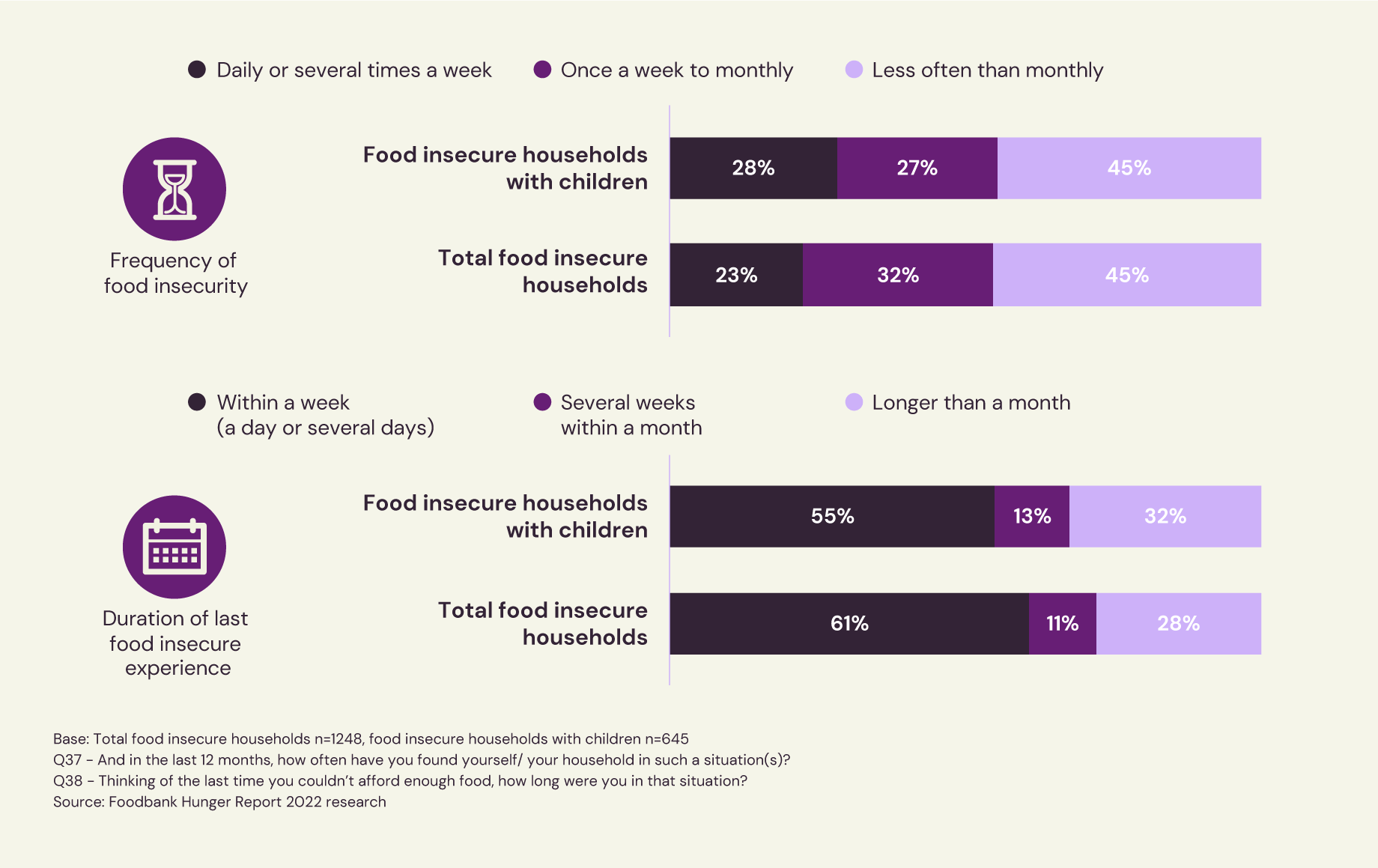
In addition to high cost of living and low income, changes to family dynamics are also a reason for food insecurity for families with children
Similar to food insecure households overall, high cost of living and low income are the top two contributing factors to household food insecurity for families with children.
In addition, family dynamics also play a role as affected families with children are more likely to cite ‘changes in household living arrangements’ as a contributing factor (28%) – driven by a higher-than-average proportion of households stating, ‘family breakdown or separation’ (12%) or ‘having new household members’ (9%) as reasons.
Food insecure households with children are also more likely to be in that situation due to natural disasters (25%) than food insecure households overall (19%).
Key reasons for food insecurity in households with dependent children

There is stronger engagement with the food relief sector by families with children
Encouragingly, food insecure families with children are more likely to have received food relief support from the food relief sector over the last 12 months (44% vs 36% of the total food insecure). However, this still leaves 54% of food insecure families without food relief.
Of the families in need who have received support from the food relief sector last year, 68% received help on a weekly basis.
- They were also the families that regularly encountered the most frequent food insecurity situations (at least several times a month or more often), indicating that the level of sector support delivered to this group was being delivered to those most in need.
The barriers to receiving food relief support was similar to those for other food insecure Australians, with two exceptions:
- Embarrassment or shame was a weaker barrier for the families with children (35% vs 40%)
- “Already exceed the food relief allowed’ was a stronger barrier for families with children (14% vs 10%), indicating that this might be a unique, family-specific barrier for the sector to address.
Close panel

“I said I didn’t have an appetite and told them to cook only for themselves. I cut portions on my own meal and told the kids and wife that I wasn’t feeling well and was going to get tested for Covid.”
Dad in remote Western Australia
The rising cost of living is the primary culprit
The most common reason for households experiencing food insecurity in the last 12 months was increased or high cost of living, followed by reduced or low incomes or benefits. Click on the reasons below to see more details.
Food insecurity impacts a variety of households across different demographic and socioeconomic characteristics.
While certain groups (e.g. households with children) are significantly more prone to food insecurity, the problem is also penetrating increasing proportions of households from the typically less vulnerable demographic groups.
For example, over half of food insecure households (54%) had someone in paid work and nearly a third of households with mortgages (30%) experienced food insecurity in the last year.
This diversity is likely to increase due to the range of external factors now at play, such as the rising cost of living, the ongoing challenge of COVID-19 and the frequency and severity of natural disasters.
‘Increased/high cost of living’ as a reason for food insecurity – households (HH) by demographics
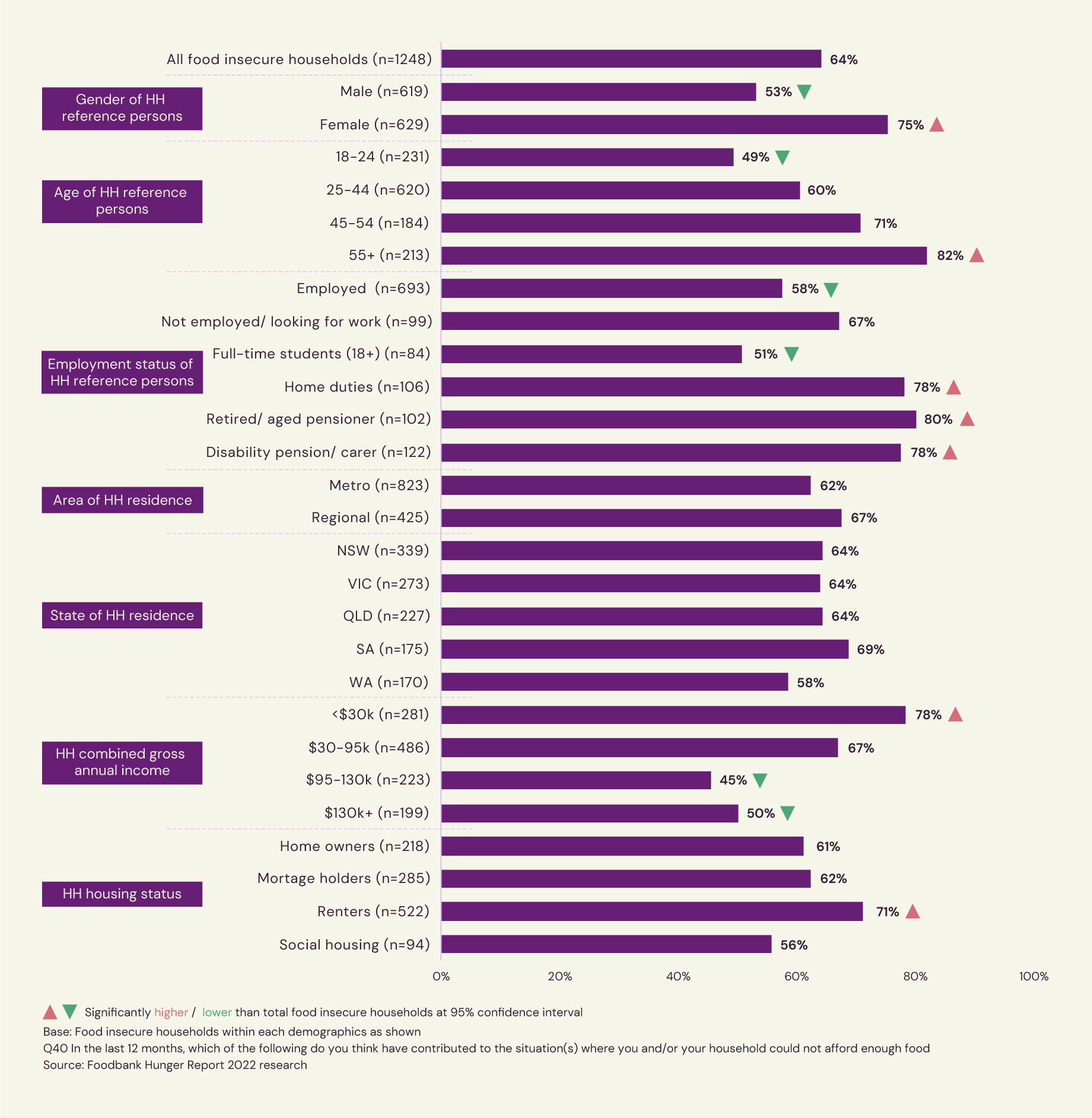
‘Reduced/ low income or government benefits’ as a reason for food insecurity – by demographics
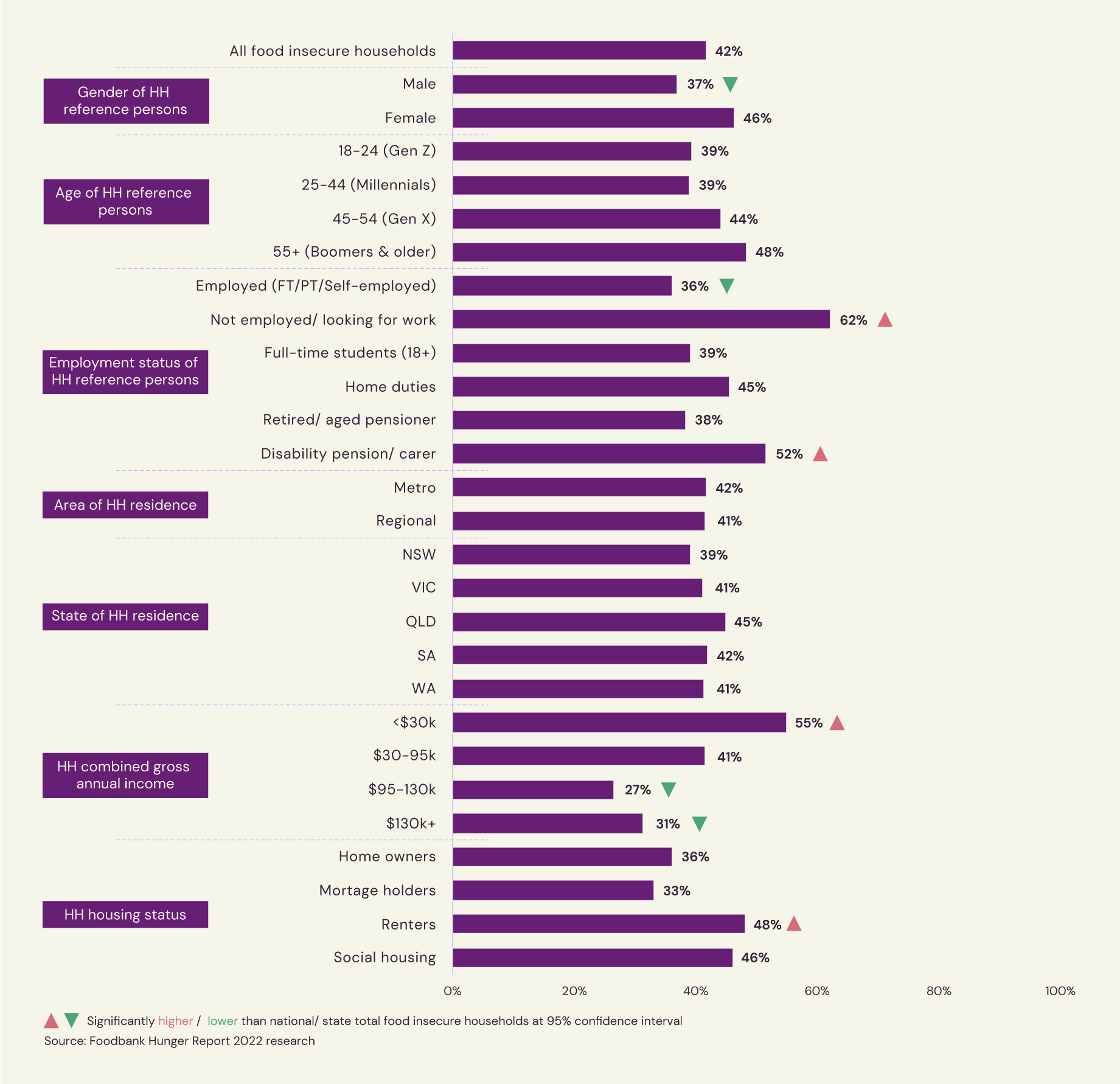
’Natural disasters (e.g. flood, bushfire, drought)’ as a reason for food insecurity – by demographics (AU, NSW, QLD)
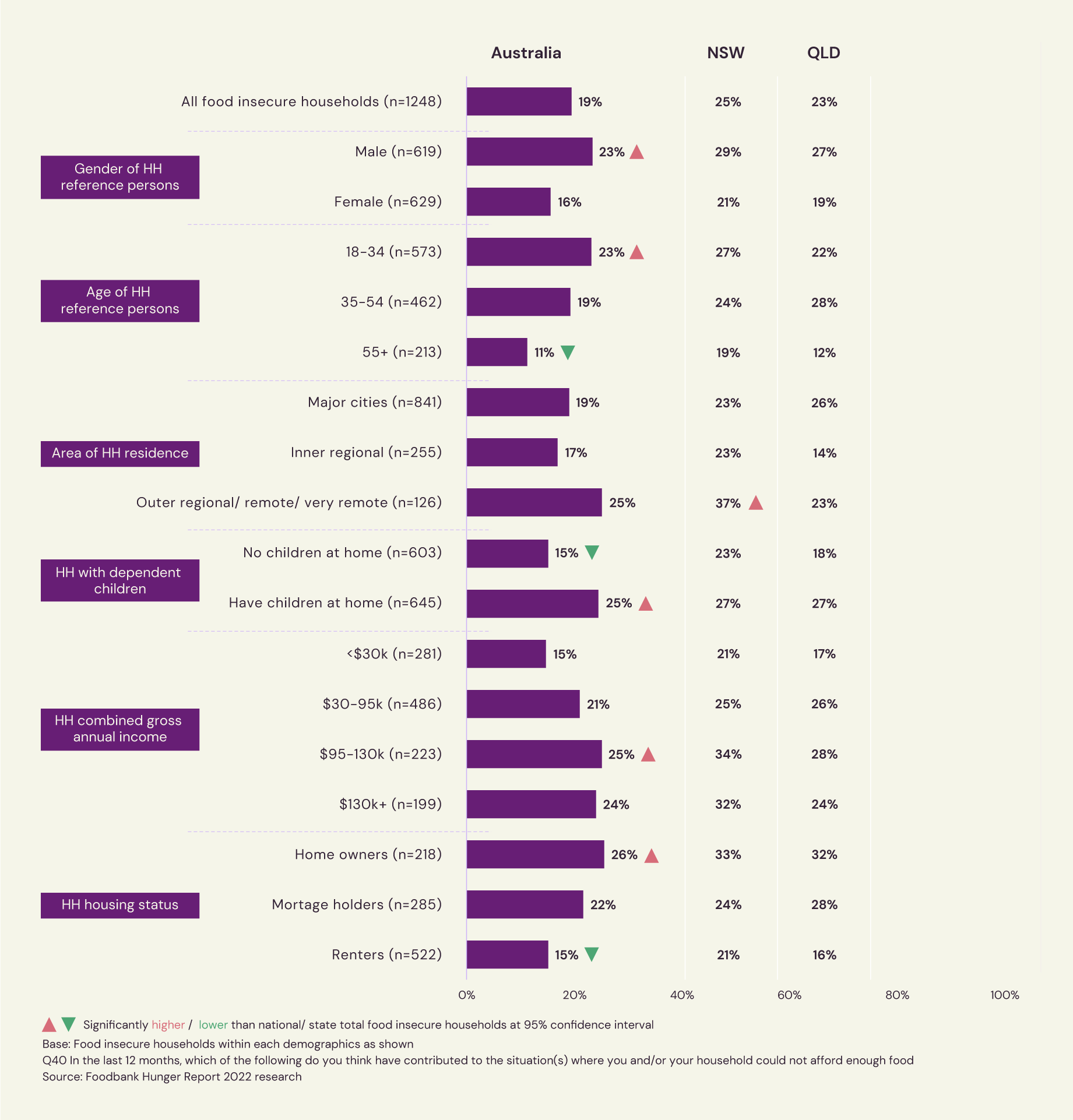
Close panel

“The sudden sharp increase in groceries has meant I’ve had to improvise with the shopping. We aren’t eating as healthy now because it is too expensive. The meals I make are filling, but not healthy long term, because we can’t afford to spend more on groceries ”
Father in suburban New South Wales
The daily challenge of having adequate and nutritious food is only increasing
The challenge of having adequate and nutritious food is only increasing, with over 55% of food insecure households reporting that they’re unable to afford food more often this year than last.
In the survey, respondents were asked “Compared to last year, are you in a situation this year where you cannot afford enough food for yourself and/or your household more or less often”. They could also select ‘about the same’ as last year, or that they haven’t been in that situation in the past few years.
Of all respondents surveyed (representing all Australian households), 23% reported that they are unable to afford food more often this year than last, while only 10% said they were unable to afford food less often, indicating that food affordability is worsening. For some households this may be their first food insecurity experience, whereas other households are moving down the food insecurity continuum (from worrying about food, to reducing size of meals, to cutting out meals altogether).
This is especially true for those households experiencing the most severe form of food insecurity. For those experiencing moderate food insecurity, 36% believed that their circumstances are worse this year than last, increasing to 67% for those experiencing severe food insecurity.
Close panel

“With the February storm came flooding and my roof was damaged and water damaged the ceiling too and my fridge stopped working. I’ve had to buy a new fridge and with Covid shortages, the cost of everything has gone up and, being forced to go to job network appointments, means I spend a lot more on fuel. It all adds up.”
Single mum in suburban Queensland
Crisis to chronic – the reality of household food insecurity
The day-to-day reality of food insecurity can differ greatly between households with various factors – in addition to the level of severity – playing a role in shaping the experience.
There are substantial differences in segment sizes by level of food security. It is not surprising that the more severe the household food insecurity is, the more likely the individuals or families experience longer-term and more persistent cycles of battle and recovery.
Distribution of food insecure households by level of severity on the continuum of crisis to chronic

Delving into this further, of particular interest are the timings of the food insecurity events, e.g. the duration of the most recent experience and how transient or persistent the experience was. For most, food insecurity is a very recent experience.
The majority (59%) of food insecure households in 2022 had experienced food insecurity within the last month, rising to 71% for those living with more severe food insecurity.
Recency of household food insecurity

For many of those experiencing food insecurity, it is a frequent event…
Over half (55%) of those living in food insecure households had experienced the situation more than monthly. As the level of food insecurity intensifies, it becomes an even more constant experience – with 70% of severely food insecure households experiencing it at least monthly.
Frequency of household food insecurity

…but the duration of food insecure episodes is varied
Across those experiencing food insecurity, the most recent experience lasted for less than a week for the majority (61%). For those who didn’t or couldn’t overcome the situation within the one-week milestone, however, the situation could deepen into a much longer-term experience.
Duration of household food insecurity
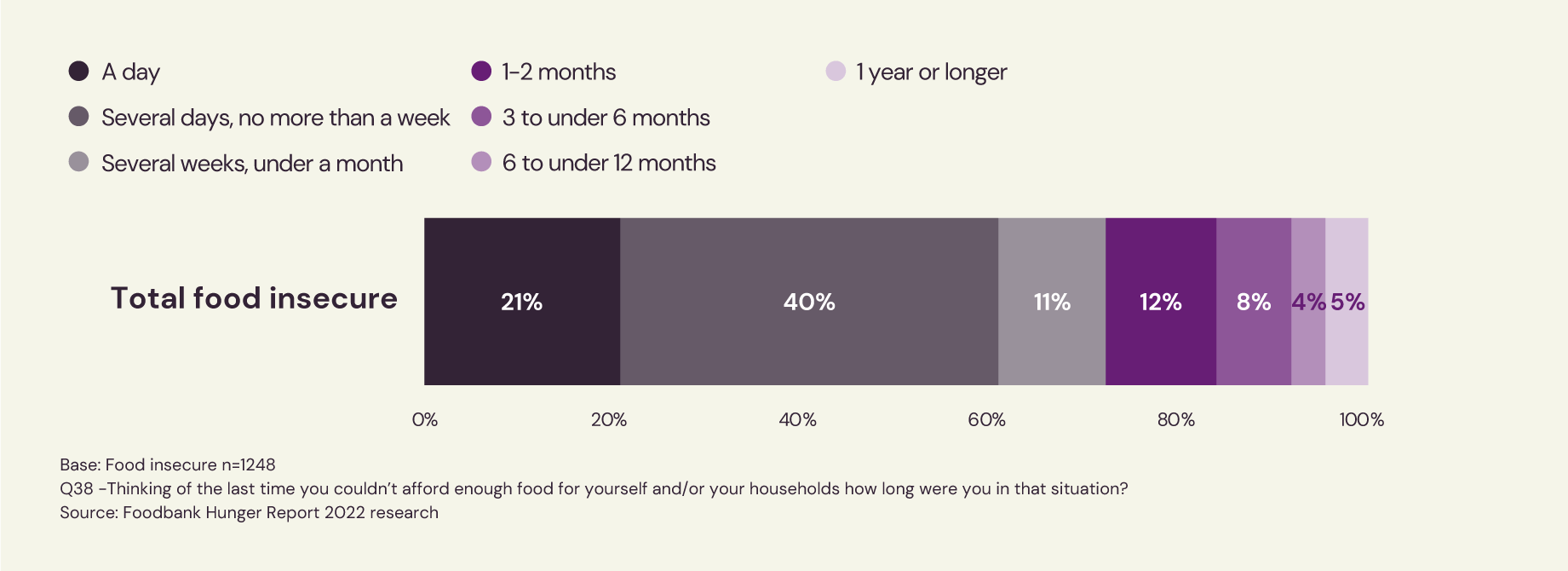
Close panel
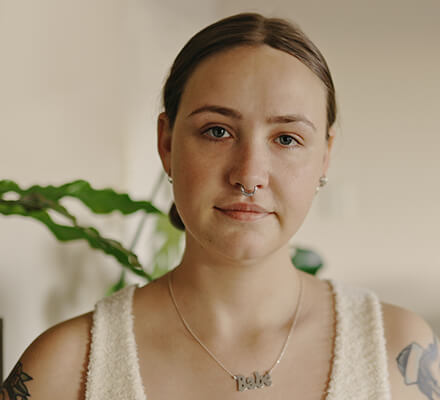
“Before a friend recommended Foodbank to me, I had $10 a fortnight left over for food and could only afford to eat toast.”
Read more“
Before a friend recommended Foodbank to me, I had $10 a fortnight left over for food and could only afford to eat toast.
I would go to my parents for a meal a couple of times a week. I also started going to church more often because parishioners would bring in leftover fruit from their fruit trees and I could take as much as I liked. Foodbank has made me feel more independent with a much more balanced and healthy diet.
”
A woman in suburban South Australia
Close panel
On a typical day, 306,000 households are receiving food relief
This equates to just over a third of food insecure households receiving support from formal food relief services over the last 12 months. About the same amount (including some of the same households) received support from family and friends.
Currently, the food relief sector is delivering support for approximately one million food insecure households in a typical month.
To understand the level of engagement with food relief services amongst food insecure Australians, respondents were shown a range of formal food relief services available, with example organisations for illustration. They were then asked to rate their awareness of each of these services, as well as any experience of receiving food relief support from them in the last 12 months.
Almost all (92%) food insecure respondents were aware of different types of formal food relief support and services such as charities, community service organisations, churches and dedicated food relief agencies.
Despite strong awareness of food relief organisations and services, however, only 38% of food insecure Australians reported receiving help from these services over the last 12 months.
Moreover, the low level of participation in formal food relief services does not mean these food insecure Australians received help through private connections. Only 37% of food insecure respondents stated that they received help from their families and/or friends over the last 12 months.
In summary, while the vast majority of food insecure Australians are aware of sources of food relief support – privately through families and/or friends or via formal food relief support services – only 58% are getting help.
Food insecure % who have received food relief from any formal food relief service (e.g. charities, community service organisations, churches, and dedicated food relief agencies) in the last 12 months – households (HH) by demographics
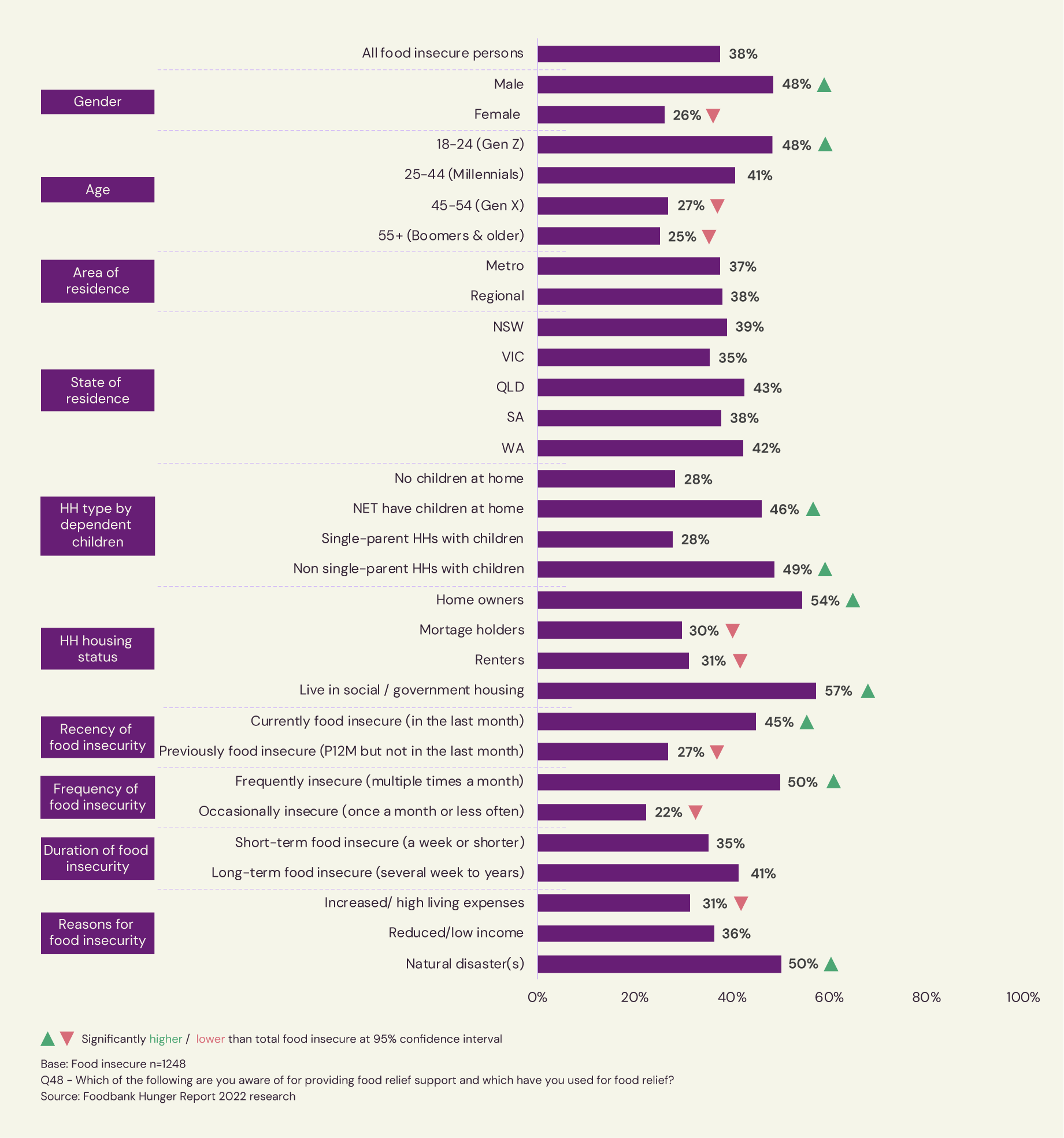
In summary, the more vulnerable demographic or socioeconomic groups are not just under-accessing formal food relief support but are also more likely to have received no help at all, even from families and friends.
Barriers to engaging with formal food relief support services
The top two barriers to accessing formal food relief for severely food insecure Australians are perceptual rather than physical – shame or embarrassment as well as the belief that others are in greater need of assistance.
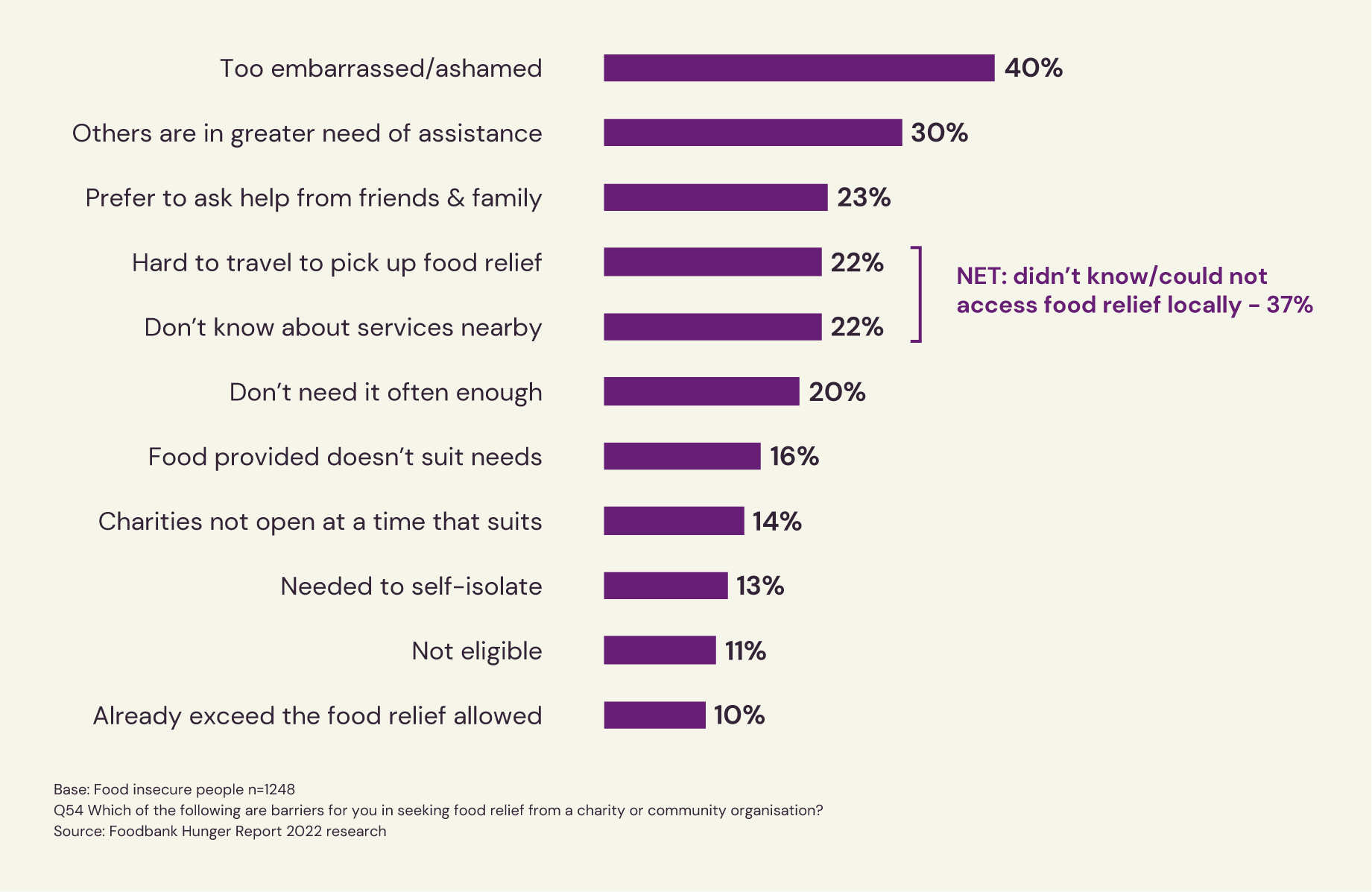
Relationship with formal food relief support services
For food insecure Australians who receive help from formal food relief services, engagement is frequent, as 61% stated they receive support at least weekly, with little difference between the different sources of help. On average, approximately 306,000 food insecure households received food relief support from the sector on any typical day.
Frequency of receiving food relief support
Last 12 months (L12M)
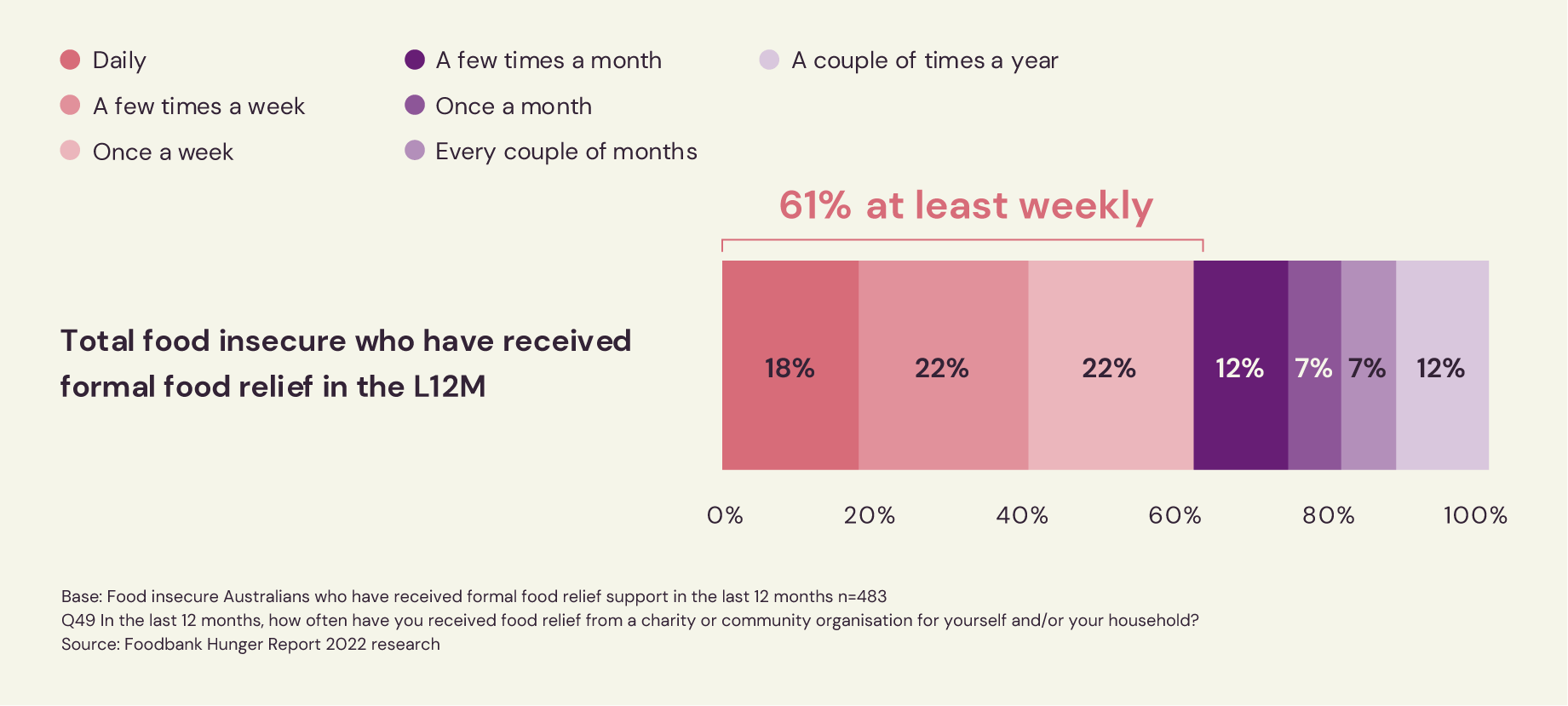
Close panel
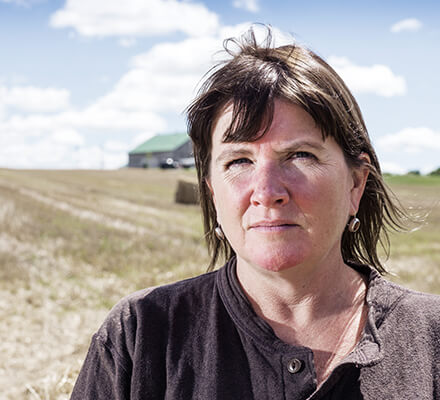
“I live off the cheapest cereal with milk made from skim milk powder three times a day. As a special treat once a month or so I can afford some mince, lentils and pasta.”
Read her full comment“
In the last few years, I’ve had to move 4 times because my landlords have sold their properties (to benefit from the increase in property prices). Moving has been expensive and each time my rent has increased. During this, I’ve had difficulty finding spare money for food.
I live off the cheapest cereal with milk made from skim milk powder three times a day. As a special treat once a month or so, I can afford some mince, lentils and pasta.
”
A woman in country South Australia
Close panel
The economic context
Read the details hereSummary
Cost of living
As the Foodbank Hunger Report 2022 shows, 64% of households cited increased/high cost of living as a reason why they couldn’t meet their household food needs. Some of the key underlying factors contributing to cost of living pressures are:
- Above average inflation
- Elevated food inflation
- Subdued below average wages growth
- Elevated household debt level extremely sensitive to interest rate rises
- Household savings rates declining rapidly
The average mortgage in Australia is approximately $600,000 so every 25 basis points rate increase costs the household an additional $125 per month in mortgage repayments.
In addition, food inflation is at 7-10%, so the average household is looking at an extra $100 per month on top of their annual grocery bill of $13,000.
This adds up to total incremental costs of $2,700 per annum for an average household with a mortgage. In essence a household will have to earn an extra $4,285 per year to cover the average cost of just these two primary expenses. There are, of course, many other costs that are also increasing – energy, fuel, public transport, telecommunications, medical, personal care and clothing.
With wages growth stalling at just 2-3% of current levels, households are having to reduce spending to cope with the increasing cost of living. When bills need to be paid, food often becomes the discretionary item in the household budget.
Poverty
According to a report published in October 2022 by the Australian Council of Social Service and the University of New South Wales, the poverty line (based on 50% of median household after-tax income) is $489 a week for a single adult and $1,027 a week for a couple with two children, based of the latest data from the Australian Bureau of Statistics.
More than one in eight people in Australia (13.4%) lived below the poverty line in 2019-20, the first year of the pandemic. That amounts to 3,319,000 people. One in six children (16.6%) lived in poverty. That amounts to 761,000 children.
The poverty rate soared to 14.6% in the March quarter of 2020 due to Covid-19 restrictions, but it fell to 12% (a 17 year low) in the June quarter of 2020 due to boosted income support payments.
The boosted payments brought 646,000 people (or 2.6% of all people) out of poverty. The child poverty rate rose from 16.2% in the September quarter of 2019 to 19% in the March quarter of 2020. It then fell to 13.7% (a two-decade low) in June 2020.
Average weekly incomes of people in poverty (from different-sized families) are $304 below the poverty line. This is known as the poverty gap. The poverty gap increased steadily from $168 a week in 1999 to $323 in March 2020 and then fell to $310 in June 2020 due to the extra Covid-19 income support.
32,000 households recorded no income in the last financial year, an increase from 22,000.
Forecast
Inflation
The inflation rate in Australia is expected to be 6.5% by the end of 2022, according to Trading Economics global macro models and analysts’ expectations. In the long-term, the Australia Inflation Rate is projected to trend around 3.5% in 2023 and 2.5% in 2024. With consumer price inflation rising to one of the highest levels in the past 20 years, consumer savings and purchasing power have been steadily eroded.
Food Inflation
Food inflation in Australia is expected to be 6.5% by the end of 2022 and will decline to around 4% by the end of 2023. This level of food inflation is still elevated and combined with a CPI of over 6%, means that the struggle with basis living costs will increase further for many Australians living on minimum wages.
Wage Growth
Wage growth in Australia is expected to be 3% by the end of 2022, according to Trading Economics global macro models and analysts’ expectations. In the long-term, the Australia Annual Change in Hourly Rates of Pay is projected to trend around 2% in 2023 and 2.3% in 2024, according to econometric models. Subdued wages growth against a backdrop of some of the highest inflation rates on record, mean that consumers will be enduring real cost of living increases with no wages growth to alleviate them.
Household Debt
Household debt to GDP in Australia is expected to be 122.7% of GDP by the end of this quarter. In the long-term, the Australia Households Debt to GDP is projected to trend around 127.3% of GDP in 2023. Australian households have the highest debt levels in recorded history. This means that any changes to interest rates will severely impact consumer disposable income as households struggle to make mortgage repayments or deal with rising rent, as property owners act to cover the rising mortgage costs of investor loans which are set at much higher interest rates than owner-occupied properties.
Personal Savings
Personal savings in Australia are expected to be 8.3% by the end of this quarter, according to Trading Economics global macro models and analysts’ expectations. In the long-term, the Australia Household Saving Ratio is projected to trend at around 8% in 2023 and 6% in 2024. The decline in savings ratios reflects the mismatch between wages growth and the escalating cost of living. The abnormal increase in savings rate through the period 2020-2021, is reflective of the Government’s income support payments during the pandemic. With the removal of these payments, household savings rates have steadily decreased as the central bank policies have taken effect.
Close panel
Methodology
Read the details hereThis report presents key findings from the Foodbank Hunger Report 2022 research which was conducted between 11 and 28 July 2022, through an online survey of 4,024 Australians aged 18 years or older. The sample was nationally representative by age, gender and location (capital city / rest of state) in each major state, with stratified quotas to ensure all major states have a robust minimum sample size of n=600 or above.
All 4,024 Australians answered up to 18 questions in the United States Department of Agriculture Household Food Security Survey Module (HFSSM) for measurement of the prevalence of household food security over the 12 months ending July 2022.
A total of 1,735 respondents (33%) were identified through the HFSSM as being from moderately and severely food insecure households. This group continued on to answer a deep dive module about their experience living with food insecurity over the last 12 months.
Close panel
Foodbank Australia would like to thank the following, without whom the Foodbank Hunger Report would not be possible:
The individuals who shared their lived experience in the Foodbank Hunger Report Survey, providing insights into the challenges they face in meeting their daily food needs. Please note all images associated with quotes are stock photos.
The hard-working state and territory Foodbanks who are always prepared to take time from their vital work to respond to our requests for feedback and on-the-ground intelligence and observations.
Big Village for undertaking the Foodbank Hunger Report Survey and undertaking detailed analysis of this and other sources of data to provide the basis for this report.
The Art of More for providing additional analysis to inform and verify the final report.
SHARE (Solutions supporting Household food security in Australia through Research and Evidence) for providing guidance and review on the development of the report.
Ron Wood for providing insight on the economic context to the report.
Russell Moverley for the design of the report.
TBST Digital for the development of the report website.
The Australian Government Department of Agriculture, Water and Environments’ financial contribution via the Fight Food Waste Cooperative Research Centre project: Enhancing Foodbank’s stakeholder engagement.
This report may be quoted for the purposes of research, discussion, record keeping, educational use and other public benefit, provided that such reproduction acknowledges Foodbank Australia.
Foodbank Australia Limited
ABN 58 073 579 254 +61 2 9887 4144 admin@foodbank.org.au foodbank.org.au
Facebook: https://www.facebook.com/FoodbankAus
Twitter: https://twitter.com/FoodbankAus
LinkedIn: https://au.linkedin.com/company/foodbank-australia
Instagram: https://www.instagram.com/foodbankaus
Close panel
